 Le rovine di Tiahuanaco sono una meta ambita per chi vuole sbirciare tra i resti di una civiltà vissuta prima del 600 AC.
Il sito archeologico con l'omonimo paesino distano solamente 70 km da La Paz, praticamente ce l'avevamo ad un tiro di schioppo, non ce lo potevamo perdere.
Da turisti fai-da-te decidiamo di andare con il bus invece che con un tour di un giorno.
L'autobus si prende vicino al cimitero, che per arrivarci da Sopocachi, il quartiere dove eravamo noi, e' un sali scendi di strade dove anche il taxi ha arrancato.
Ci abbiamo messo 40 minuti invece di 15, non voglio nemmeno parlare del traffico di La Paz che e' peggio di quello di Roma, incredibile ma vero.
Siamo arrivati al bus giusto in tempo per l'ultima corsa delle 18 che andava al confine con il Peru', ma passava davanti al paese; quindi in 1 ora e 30 avremmo dovuto essere a destinazione. Siamo saliti su questo affollato e colorato autobus tra donne boliviane con gonnellone e bambini al sacco, avvertendo l'autista che ci doveva fermare all'incrocio. Dopo circa due ore di viaggio Pietro casualmente e' andato a chiedere quanto mancava, venendo cosi a scoprire che il simpatico autista si era dimenticato di farci scendere.
Eravamo ad un paesotto a circa 15 km da Tiahuanaco nel mezzo del nulla, su di una strada senza luci e sinceramente non ci siamo accorti di essere passati davanti alla nostra meta. L'autista, scusandosi mille volte, ci ha fatto scendere davanti ad una caserma militare dove c'era un posto di blocco in entrambi i lati, crediamo per via della vicinanza con il confine peruviano.
Qui e' stato ilare: sono passate molte macchine e camion che andavano verso La Paz ma cariche di persone o altro; i tanti militari presenti si sono avvicinati a turno per chiedere che diavolo stessimo aspettando tutti incappucciati e con gli zaini nel mezzo della strada, ho dimenticato di dire che faceva freddo, ovviamente; noi che volevamo tanto fare l'esperienza dell'autostop ma non al buio e, soprattutto, non in Bolivia. Insomma alla fine un ufficiale a cui abbiamo fatto pena ha chiesto ad una famigliola con un bimbo di caricarci; il tipo anche se inizialmente non sprizzasse gioia da tutti i pori – aveva visto Pietro per primo, haha!, alla fine ci ha accompagnati davanti al hotel a Tiahuanaco, aggiungendo che non era sicuro farsela a piedi. Appunto!
Le rovine di Tiahuanaco sono una meta ambita per chi vuole sbirciare tra i resti di una civiltà vissuta prima del 600 AC.
Il sito archeologico con l'omonimo paesino distano solamente 70 km da La Paz, praticamente ce l'avevamo ad un tiro di schioppo, non ce lo potevamo perdere.
Da turisti fai-da-te decidiamo di andare con il bus invece che con un tour di un giorno.
L'autobus si prende vicino al cimitero, che per arrivarci da Sopocachi, il quartiere dove eravamo noi, e' un sali scendi di strade dove anche il taxi ha arrancato.
Ci abbiamo messo 40 minuti invece di 15, non voglio nemmeno parlare del traffico di La Paz che e' peggio di quello di Roma, incredibile ma vero.
Siamo arrivati al bus giusto in tempo per l'ultima corsa delle 18 che andava al confine con il Peru', ma passava davanti al paese; quindi in 1 ora e 30 avremmo dovuto essere a destinazione. Siamo saliti su questo affollato e colorato autobus tra donne boliviane con gonnellone e bambini al sacco, avvertendo l'autista che ci doveva fermare all'incrocio. Dopo circa due ore di viaggio Pietro casualmente e' andato a chiedere quanto mancava, venendo cosi a scoprire che il simpatico autista si era dimenticato di farci scendere.
Eravamo ad un paesotto a circa 15 km da Tiahuanaco nel mezzo del nulla, su di una strada senza luci e sinceramente non ci siamo accorti di essere passati davanti alla nostra meta. L'autista, scusandosi mille volte, ci ha fatto scendere davanti ad una caserma militare dove c'era un posto di blocco in entrambi i lati, crediamo per via della vicinanza con il confine peruviano.
Qui e' stato ilare: sono passate molte macchine e camion che andavano verso La Paz ma cariche di persone o altro; i tanti militari presenti si sono avvicinati a turno per chiedere che diavolo stessimo aspettando tutti incappucciati e con gli zaini nel mezzo della strada, ho dimenticato di dire che faceva freddo, ovviamente; noi che volevamo tanto fare l'esperienza dell'autostop ma non al buio e, soprattutto, non in Bolivia. Insomma alla fine un ufficiale a cui abbiamo fatto pena ha chiesto ad una famigliola con un bimbo di caricarci; il tipo anche se inizialmente non sprizzasse gioia da tutti i pori – aveva visto Pietro per primo, haha!, alla fine ci ha accompagnati davanti al hotel a Tiahuanaco, aggiungendo che non era sicuro farsela a piedi. Appunto!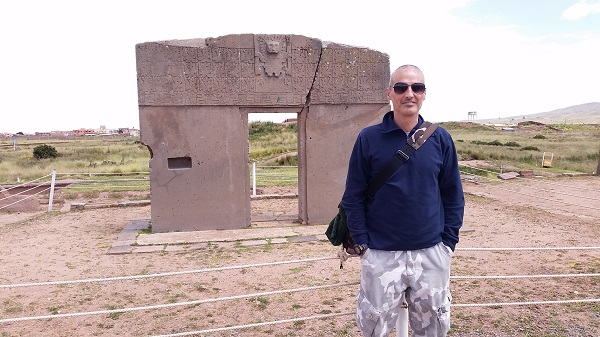 Il sito archeologico
Ce lo siamo goduto la mattina presto, dormendo in loco almeno abbiamo approfittato.
Le rovine si trovano a 3.885 m di altezza a circa 15 km dal lago Titicaca, nostra prossima meta.
La cultura Tiahuanaco e' stata una tra le più longeve in America del Sud tra il 1500 AC al 1200DC, il suo dominio fisico si estendeva per 600.000 km2. Ci sono testimonianze della loro esistenza in Argentina, Cile, Bolivia, Ecuador e Perù, dove si possono vedere i resti del loro sviluppo nell'architettura, nelle scienze, nell'astronomia e nelle tecniche.
La Puerta del Sol nel Tempio del Sole
E' il monumento dei Tiahuanaco più conosciuto a livello mondiale per la perfezione della costruzione e dei basso rilievi che la ricoprono. La porta e' un solo blocco di pietra di circa 10 tonnellate di peso, che nell'antichità faceva parte di un edificio più grande ubicato sulla Piramide di Akapana o nel sito kalasasaya, dove si trovano altri pezzi della stessa pietra della porta. Il kalasasaya (o tempio delle pietre ferme) e' spettacolare in quanto la struttura e' collegata perfettamente con il calendario astrologico: nell'equinozio del 21 di marzo e del 21 di settembre il sole nasceva nel centro dalla porta principale di ingresso, mentre nel solstizio di inverno (21 di giugno) il sole nasceva nell'angolo Nord Est del muro, e nel solstizio estivo (21 di dicembre) veniva su dall'angolo Sud Est delle mura. E' incredibile pensare alla perfezione di calcolo scientifico e della tecnica di costruzione dei Tiahuanaco per realizzare tutto questo.
La Piramide
Il sito archeologico
Ce lo siamo goduto la mattina presto, dormendo in loco almeno abbiamo approfittato.
Le rovine si trovano a 3.885 m di altezza a circa 15 km dal lago Titicaca, nostra prossima meta.
La cultura Tiahuanaco e' stata una tra le più longeve in America del Sud tra il 1500 AC al 1200DC, il suo dominio fisico si estendeva per 600.000 km2. Ci sono testimonianze della loro esistenza in Argentina, Cile, Bolivia, Ecuador e Perù, dove si possono vedere i resti del loro sviluppo nell'architettura, nelle scienze, nell'astronomia e nelle tecniche.
La Puerta del Sol nel Tempio del Sole
E' il monumento dei Tiahuanaco più conosciuto a livello mondiale per la perfezione della costruzione e dei basso rilievi che la ricoprono. La porta e' un solo blocco di pietra di circa 10 tonnellate di peso, che nell'antichità faceva parte di un edificio più grande ubicato sulla Piramide di Akapana o nel sito kalasasaya, dove si trovano altri pezzi della stessa pietra della porta. Il kalasasaya (o tempio delle pietre ferme) e' spettacolare in quanto la struttura e' collegata perfettamente con il calendario astrologico: nell'equinozio del 21 di marzo e del 21 di settembre il sole nasceva nel centro dalla porta principale di ingresso, mentre nel solstizio di inverno (21 di giugno) il sole nasceva nell'angolo Nord Est del muro, e nel solstizio estivo (21 di dicembre) veniva su dall'angolo Sud Est delle mura. E' incredibile pensare alla perfezione di calcolo scientifico e della tecnica di costruzione dei Tiahuanaco per realizzare tutto questo.
La Piramide
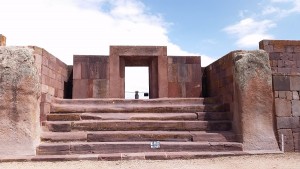 Era alta 800m e aveva 7 gradoni; la parte alta era adibita ai culti religiosi e all'astrologia: c'era una fonte d'acqua che permetteva di studiare le stelle sul suo riflesso. Per la costruzione si utilizzarono tecniche diverse e per questo pensano che abbiano impiegato molto tempo per tirarla su. Peccato che ci siano pochi resti oggi: solo il 30% e' visibile, il resto e' tutto sottoterra poiche' la scarsità di fondi non aiuta le ricerche; inoltre di quel 30%, i conquistadores e gesuiti hanno smantellato le costruzioni originarie anche con la dinamite per poter costruire le chiese locali.
Monolito Bennett o Pachamama
Questa e' una statua di 20 tonnellate, alta 7 metri di cui 2 sono interrati. La statua e' stata scoperta dall'archeologo americano Clark Bennett, da cui ha preso il nome, e rappresenta la Madre Terra (Pachamama). Il monolito e' ricoperto da bassorilievi significativi che hanno dato tante informazioni sulla civilta' Tiahuanaco: rispetto per la donna che tutto crea, rapporto di reciprocità con la madre terra, importanza al dualismo luce/buio – giorno/notte nella vita, adorazione per il puma, il condor, il llama e il pesce come animali simbolici per fuoco, aria, terra e acqua. C'è molto altro ancora che ci ha affascinati e tenuto occupati per un'intera giornata.
Abbiamo avuto una guida del posto molto capace, Frances, che contento ci ha raccontato un po' di vita locale e di aver preso parte al gruppo di lavoro per la conservazione del Tempio del Sol sotto la direzione di Patrizia Di Cosimo, archeologa italiana.
Dopo la visita, abbiamo deciso d'istinto di andare a Copacabana, citta' a nord di La Paz sul lago Titicaca, quindi abbiamo preso un minibus per arrivare a La Paz in un'oretta e poi un altro autobus per Copa con tre ore di viaggio.
La varietà e l'odore di umanità di cui abbiamo fatto esperienza in questo pomeriggio ci rimarrà impressa a lungo.
Era alta 800m e aveva 7 gradoni; la parte alta era adibita ai culti religiosi e all'astrologia: c'era una fonte d'acqua che permetteva di studiare le stelle sul suo riflesso. Per la costruzione si utilizzarono tecniche diverse e per questo pensano che abbiano impiegato molto tempo per tirarla su. Peccato che ci siano pochi resti oggi: solo il 30% e' visibile, il resto e' tutto sottoterra poiche' la scarsità di fondi non aiuta le ricerche; inoltre di quel 30%, i conquistadores e gesuiti hanno smantellato le costruzioni originarie anche con la dinamite per poter costruire le chiese locali.
Monolito Bennett o Pachamama
Questa e' una statua di 20 tonnellate, alta 7 metri di cui 2 sono interrati. La statua e' stata scoperta dall'archeologo americano Clark Bennett, da cui ha preso il nome, e rappresenta la Madre Terra (Pachamama). Il monolito e' ricoperto da bassorilievi significativi che hanno dato tante informazioni sulla civilta' Tiahuanaco: rispetto per la donna che tutto crea, rapporto di reciprocità con la madre terra, importanza al dualismo luce/buio – giorno/notte nella vita, adorazione per il puma, il condor, il llama e il pesce come animali simbolici per fuoco, aria, terra e acqua. C'è molto altro ancora che ci ha affascinati e tenuto occupati per un'intera giornata.
Abbiamo avuto una guida del posto molto capace, Frances, che contento ci ha raccontato un po' di vita locale e di aver preso parte al gruppo di lavoro per la conservazione del Tempio del Sol sotto la direzione di Patrizia Di Cosimo, archeologa italiana.
Dopo la visita, abbiamo deciso d'istinto di andare a Copacabana, citta' a nord di La Paz sul lago Titicaca, quindi abbiamo preso un minibus per arrivare a La Paz in un'oretta e poi un altro autobus per Copa con tre ore di viaggio.
La varietà e l'odore di umanità di cui abbiamo fatto esperienza in questo pomeriggio ci rimarrà impressa a lungo.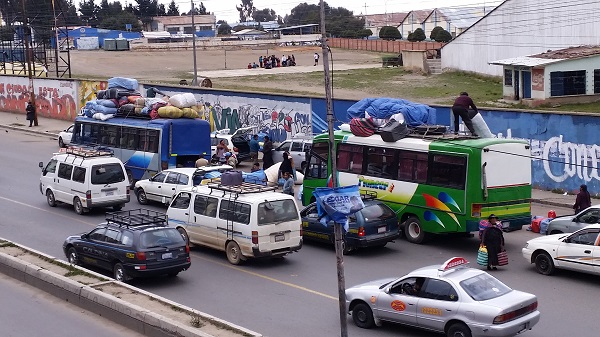
Bolivia – Tiahuanaco
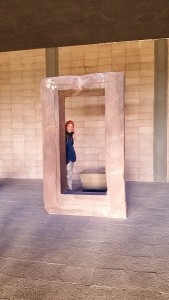 The ruins of Tiwanaku are a popular destination for those who want to peek through the remains of a civilization lived before 600 BC. The archaeological site with the eponymous village is at only 70 km away from La Paz, practically we had it behind the corner, we could not miss it.
As tourists do-it-yourself, we decided to go by bus instead of a day tour with a group.
The bus left from the cemetery, up the hill, and to get there from Sopocachi, the neighborhood where we were, it was an up and down between streets where even the taxi trudged. To reach the bus stop, we took 40 minutes instead of 15, I will not even mention the traffic of La Paz which is even worse than one in Rome, believe it or not.
We arrived at the bus just in time for the last one at 6pm; this went to the border with Peru', but it passed by our destination, Tiwanaku village. In 1 hour and 30 mins, we should have reached the place. We got into this crowded and colorful bus, finding our sites between Bolivian women with big skirts and children in their bags, warning the driver that we had to stop at the intersection.
After about two hours of travel, Pietro accidentally went to ask how far was the stop, and instead he found out that the driver forgot to let us off.
The ruins of Tiwanaku are a popular destination for those who want to peek through the remains of a civilization lived before 600 BC. The archaeological site with the eponymous village is at only 70 km away from La Paz, practically we had it behind the corner, we could not miss it.
As tourists do-it-yourself, we decided to go by bus instead of a day tour with a group.
The bus left from the cemetery, up the hill, and to get there from Sopocachi, the neighborhood where we were, it was an up and down between streets where even the taxi trudged. To reach the bus stop, we took 40 minutes instead of 15, I will not even mention the traffic of La Paz which is even worse than one in Rome, believe it or not.
We arrived at the bus just in time for the last one at 6pm; this went to the border with Peru', but it passed by our destination, Tiwanaku village. In 1 hour and 30 mins, we should have reached the place. We got into this crowded and colorful bus, finding our sites between Bolivian women with big skirts and children in their bags, warning the driver that we had to stop at the intersection.
After about two hours of travel, Pietro accidentally went to ask how far was the stop, and instead he found out that the driver forgot to let us off.
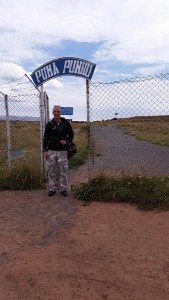 We were in a little town about 15 miles from Tiahuanaco in the middle of nowhere, on a road with no lights and frankly we did not realize to having passed our village. The driver apologised a thousand times, dropped us off in front of a military barracks where there was a checkpoint on both sides, we believe because of the proximity with the Peruvian border.
Here it was hilarious: lots of cars and trucks passed, going to La Paz, but full of people or another; many soldiers approached us in turns to ask what the hell we were waiting for, all hooded and with backpacks in the middle of the road (I forgot to mention that it was cold, of course).
We wanted so much to experience hitch-hacking, but not in the dark, and especially not in Bolivia. So in the end, an official asked a family with a child to give us a lift: the guy although initially wasn't shooting out joy from every pore – he saw Pietro first, haha!, finally took us in front of the hotel in Tiahuanaco, adding that it was not safe to walk there in the dark. Right!
The archaeological site
There we enjoyed the early morning, sleeping in the premises the night before, at least we took advantage of it.
The ruins are located at 3,885m height at about 15 km from Lake Titicaca, our next destination.
The Tiwanaku culture was one of the longest one in South America between 1500BC to 1200DC, its physical domain stretched for 600,000 km2. There is evidence of their existence in Argentina, Chile, Bolivia, Ecuador and Peru, where you can see the remains of their development in architecture, science, astronomy and techniques.
The Puerta del Sol in the Temple of the Sun
We were in a little town about 15 miles from Tiahuanaco in the middle of nowhere, on a road with no lights and frankly we did not realize to having passed our village. The driver apologised a thousand times, dropped us off in front of a military barracks where there was a checkpoint on both sides, we believe because of the proximity with the Peruvian border.
Here it was hilarious: lots of cars and trucks passed, going to La Paz, but full of people or another; many soldiers approached us in turns to ask what the hell we were waiting for, all hooded and with backpacks in the middle of the road (I forgot to mention that it was cold, of course).
We wanted so much to experience hitch-hacking, but not in the dark, and especially not in Bolivia. So in the end, an official asked a family with a child to give us a lift: the guy although initially wasn't shooting out joy from every pore – he saw Pietro first, haha!, finally took us in front of the hotel in Tiahuanaco, adding that it was not safe to walk there in the dark. Right!
The archaeological site
There we enjoyed the early morning, sleeping in the premises the night before, at least we took advantage of it.
The ruins are located at 3,885m height at about 15 km from Lake Titicaca, our next destination.
The Tiwanaku culture was one of the longest one in South America between 1500BC to 1200DC, its physical domain stretched for 600,000 km2. There is evidence of their existence in Argentina, Chile, Bolivia, Ecuador and Peru, where you can see the remains of their development in architecture, science, astronomy and techniques.
The Puerta del Sol in the Temple of the Sun
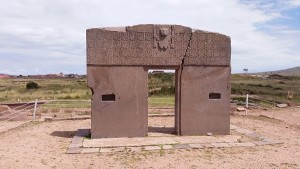 Probably this is the Tiwanaku monument best known worldwide for the perfection of the construction and low bas-reliefs that cover it. The door is a single block of stone of about 10 tons of weight, which in ancient times was part of a larger building located on the Pyramid of Akapana or the Kalasasaya site, where there are other pieces of the same stone door.
The Kalasasaya (or temple of the steady stones) is spectacular as the structure is connected perfectly with the astrological calendar: in the equinox of March 21 and September 21 the sun was born in the center of the front door entrance, while in winter solstice (June 21) the sun was born in the North East of the wall, and in the summer solstice (December 21) was on the corner of South East wall. It's amazing to think about the perfection of scientific calculation and technological construction of the Tiahuanaco to achieve all of this.
The Pyramid
It was 800m high and had seven levels of steps; the upper part was used to religious cults and astrology: there was a water source that allowed to study the stars on its reflection. To build it, they used different techniques and for this it believes they took long time to build it.
It is really bad that there are just few remains today: only 30% is visible, and the rest is all underground due to the lack of funds and a little interest in the research. Also of this 30%, the conquistadors and the Jesuits dismantled the original buildings with dynamite in order to build local churches.
Bennett Monolith or Pachamama
This is a statue of 20 tons, 7 meters high of which 2 are buried. The statue was discovered by the American Clark Bennett, from which it took its name, and represents the Mother Earth (Pachamama).
The monolith is covered with important bas-reliefs that gave so many information about the Tiwanaku civilisation: the respect for the woman, who creates everything, the reciprocal relationship with the mother-earth, importance of the dualism light/dark and day/night in life, the worship for the puma, the condor, the llama and the fish as symbolic animals for fire, air, earth and water. There is much more that has fascinated and kept us busy for the whole day.
Probably this is the Tiwanaku monument best known worldwide for the perfection of the construction and low bas-reliefs that cover it. The door is a single block of stone of about 10 tons of weight, which in ancient times was part of a larger building located on the Pyramid of Akapana or the Kalasasaya site, where there are other pieces of the same stone door.
The Kalasasaya (or temple of the steady stones) is spectacular as the structure is connected perfectly with the astrological calendar: in the equinox of March 21 and September 21 the sun was born in the center of the front door entrance, while in winter solstice (June 21) the sun was born in the North East of the wall, and in the summer solstice (December 21) was on the corner of South East wall. It's amazing to think about the perfection of scientific calculation and technological construction of the Tiahuanaco to achieve all of this.
The Pyramid
It was 800m high and had seven levels of steps; the upper part was used to religious cults and astrology: there was a water source that allowed to study the stars on its reflection. To build it, they used different techniques and for this it believes they took long time to build it.
It is really bad that there are just few remains today: only 30% is visible, and the rest is all underground due to the lack of funds and a little interest in the research. Also of this 30%, the conquistadors and the Jesuits dismantled the original buildings with dynamite in order to build local churches.
Bennett Monolith or Pachamama
This is a statue of 20 tons, 7 meters high of which 2 are buried. The statue was discovered by the American Clark Bennett, from which it took its name, and represents the Mother Earth (Pachamama).
The monolith is covered with important bas-reliefs that gave so many information about the Tiwanaku civilisation: the respect for the woman, who creates everything, the reciprocal relationship with the mother-earth, importance of the dualism light/dark and day/night in life, the worship for the puma, the condor, the llama and the fish as symbolic animals for fire, air, earth and water. There is much more that has fascinated and kept us busy for the whole day.
 We had a local and very capable tour guide, Frances: he was happy to tell us a bit of the local life and to have taken part in the working group for the preservation of the Temple of Sol conducted by Patrizia Di Cosimo , an Italian archaeologist.
After the visit, we decided by instinct to go to Copacabana, a pilgrims destination at north of La Paz on the Titicaca Lake: so we took a minibus to get to La Paz in an hour and then another bus to Copa for three hours trip.
The variety and the smell of humanity, we have experienced in that afternoon, there will be remembered for long time.
We had a local and very capable tour guide, Frances: he was happy to tell us a bit of the local life and to have taken part in the working group for the preservation of the Temple of Sol conducted by Patrizia Di Cosimo , an Italian archaeologist.
After the visit, we decided by instinct to go to Copacabana, a pilgrims destination at north of La Paz on the Titicaca Lake: so we took a minibus to get to La Paz in an hour and then another bus to Copa for three hours trip.
The variety and the smell of humanity, we have experienced in that afternoon, there will be remembered for long time. 